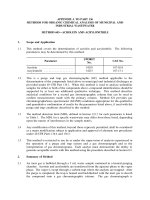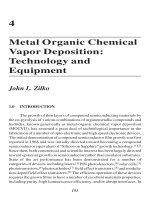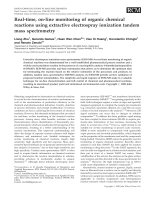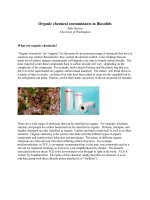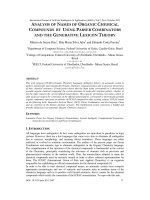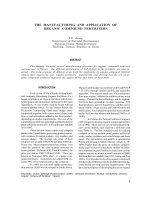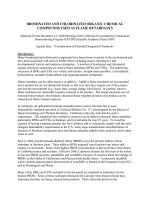Sector Notebook Project: Organic Chemical Industry pot
Bạn đang xem bản rút gọn của tài liệu. Xem và tải ngay bản đầy đủ của tài liệu tại đây (571.5 KB, 132 trang )
Sector Notebook Project Organic Chemical Industry
September 1995 SIC 286
This report is one in a series of volumes published by the U.S. Environmental Protection Agency
(EPA) to provide information of general interest regarding environmental issues associated with
specific industrial sectors. The documents were developed under contract by Abt Associates
(Cambridge, MA), and Booz-Allen & Hamilton, Inc. (McLean, VA). This publication may be
purchased from the Superintendent of Documents, U.S. Government Printing Office. A listing of
available Sector Notebooks and document numbers is included on the following page.
All telephone orders should be directed to:
Superintendent of Documents
U.S. Government Printing Office
Washington, DC 20402
(202) 512-1800
FAX (202) 512-2250
9:00 a.m. to 4:30 p.m., Eastern Time, M-F
Using the form provided at the end of this document, all mail orders should be directed to:
U.S. Government Printing Office
P.O. Box 371954
Pittsburgh, PA 15250-7954
Complimentary volumes are available to certain groups or subscribers, such as public and academic
libraries, Federal, State, local, and foreign governments, and the media. For further information, and
for answers to questions pertaining to these documents, please refer to the contact names and
numbers provided within this volume.
Electronic versions of all Sector Notebooks are available free of charge at the following web address:
www.epa.gov/oeca/sector. Direct technical questions to the “Feedback” button at the bottom of the
web page.
Cover photograph by Steve Delaney, EPA. Photograph courtesy of Vista Chemicals, Baltimore,
Maryland. Special thanks to Dave Mahler.
Sector Notebook Project Organic Chemical Industry
September 1995 SIC 286
EPA/310-R-95-012
EPA Office of Compliance Sector Notebook Project
Profile of the Organic Chemical Industry
September 1995
Office of Compliance
Office of Enforcement and Compliance Assurance
U.S. Environmental Protection Agency
401 M St., SW (MC 2221-A)
Washington, DC 20460
Sector Notebook Project Organic Chemical Industry
September 1995 SIC 286
Sector Notebook Contacts
The Sector Notebooks were developed by the EPA’s Office of Compliance. Questions relating to the Sector Notebook
Project can be directed to:
Seth Heminway, Coordinator, Sector Notebook Project
US EPA Office of Compliance
401 M St., SW (2223-A)
Washington, DC 20460
(202) 564-7017
Questions and comments regarding the individual documents can be directed to the appropriate specialists listed
below.
Document Number Industry Contact Phone (202)
EPA/310-R-95-001. Dry Cleaning Industry Joyce Chandler 564-7073
EPA/310-R-95-002. Electronics and Computer Industry* Steve Hoover 564-7007
EPA/310-R-95-003. Wood Furniture and Fixtures Industry Bob Marshall 564-7021
EPA/310-R-95-004. Inorganic Chemical Industry* Walter DeRieux 564-7067
EPA/310-R-95-005. Iron and Steel Industry Maria Malave 564-7027
EPA/310-R-95-006. Lumber and Wood Products Industry Seth Heminway 564-7017
EPA/310-R-95-007. Fabricated Metal Products Industry* Scott Throwe 564-7013
EPA/310-R-95-008. Metal Mining Industry Jane Engert 564-5021
EPA/310-R-95-009. Motor Vehicle Assembly Industry Anthony Raia 564-6045
EPA/310-R-95-010. Nonferrous Metals Industry Jane Engert 564-5021
EPA/310-R-95-011. Non-Fuel, Non-Metal Mining Industry Rob Lischinsky 564-2628
EPA/310-R-95-012. Organic Chemical Industry* Walter DeRieux 564-7067
EPA/310-R-95-013. Petroleum Refining Industry Tom Ripp 564-7003
EPA/310-R-95-014. Printing Industry Ginger Gotliffe 564-7072
EPA/310-R-95-015. Pulp and Paper Industry Seth Heminway 564-7017
EPA/310-R-95-016. Rubber and Plastic Industry Maria Malave 564-7027
EPA/310-R-95-017. Stone, Clay, Glass, and Concrete Industry Scott Throwe 564-7013
EPA/310-R-95-018. Transportation Equipment Cleaning Ind. Virginia Lathrop 564-7057
EPA/310-R-97-001. Air Transportation Industry Virginia Lathrop 564-7057
EPA/310-R-97-002. Ground Transportation Industry Virginia Lathrop 564-7057
EPA/310-R-97-003. Water Transportation Industry Virginia Lathrop 564-7057
EPA/310-R-97-004. Metal Casting Industry Jane Engert 564-5021
EPA/310-R-97-005. Pharmaceuticals Industry Emily Chow 564-7071
EPA/310-R-97-006. Plastic Resin and Man-made Fiber Ind. Sally Sasnett 564-7074
EPA/310-R-97-007. Fossil Fuel Electric Power Generation Ind. Rafael Sanchez 564-7028
EPA/310-R-97-008. Shipbuilding and Repair Industry Anthony Raia 564-6045
EPA/310-R-97-009. Textile Industry Belinda Breidenbach 564-7022
EPA/310-R-97-010. Sector Notebook Data Refresh-1997 Seth Heminway 564-7017
EPA/310-R-98-001. Aerospace Industry Anthony Raia 564-6045
EPA/310-R-98-002. Agricultural Chemical, Pesticide, and Amy Porter 564-4149
Fertilizer Industry
EPA/310-R-98-003. Agricultural Crop Production Industry Ginah Mortensen (913)551-7864
EPA/310-R-98-004. Agricultural Livestock Production Ind. Ginah Mortensen (913)551-7864
EPA/310-R-98-005. Oil and Gas Exploration and Production Dan Chadwick 564-7054
Industry
EPA/310-R-98-008. Local Government Operations John Dombrowski 564-7036
*Spanish Translations Available
Sector Notebook Project Organic Chemical Industry
September 1995 SIC 286i
Industry Sector Notebook Contents: Organic Chemicals
Exhibits Index iii
List of Acronyms iv
I. INTRODUCTION TO THE SECTOR NOTEBOOK PROJECT 1
A. Summary of the Sector Notebook Project 1
B. Additional Information 2
II. INTRODUCTION TO THE ORGANIC CHEMICALS INDUSTRY 3
A. Introduction, Background, and Scope of the Notebook 3
B. Characterization of the Organic Chemicals Industry 4
1. Industry size and geographic distribution 4
2. Product Characterization 7
3. Economic trends 9
III. INDUSTRIAL PROCESS DESCRIPTION 11
A. Industrial Processes in the Organic Chemicals Industry 11
B. Raw Material Inputs and Pollution Outputs 25
C. Management of Chemicals in the Production Process 26
IV. CHEMICAL RELEASE AND TRANSFER PROFILE 29
A. EPA Toxic Release Inventory for the Organic Chemicals Industry 32
B. Summary of Selected Chemicals Released 44
C. Other Data Sources 47
D. Comparison of Toxic Release Inventory Between Selected Industries 48
V. POLLUTION PREVENTION OPPORTUNITIES 53
VI. SUMMARY OF APPLICABLE FEDERAL STATUTES AND REGULATIONS 73
A. General Description of Major Statutes 73
B. Industry Specific Requirements 83
C. Pending and Proposed Regulatory Requirements 85
Sector Notebook Project Organic Chemical Industry
September 1995 SIC 286ii
VII. COMPLIANCE AND ENFORCEMENT PROFILE 87
A. Organic Chemicals Compliance History 91
B. Comparison of Enforcement Activity Between Selected Industries 93
C. Review of Major Legal Actions 98
1. Review of major cases 98
2. Supplementary Environmental Projects (SEPs) 98
VIII. COMPLIANCE ACTIVITIES AND INITIATIVES 103
A. Sector-related Environmental Programs and Activities 103
B. EPA Voluntary Programs 103
C. Trade Association/Industry Sponsored Activity 110
1. Environmental Programs 110
2. Summary of Trade Associations 112
IX. CONTACTS/ACKNOWLEDGMENTS/RESOURCE MATERIALS/BIBLIOGRAPHY 117
Endnotes 127
Sector Notebook Project Organic Chemical Industry
September 1995 SIC 286iii
Exhibits Index
Exhibit 1: Small Number of Large Facilities Account for Majority of Shipments 5
Exhibit 2: Organic Chemical Manufacturing Facilities (SIC 286) 5
Exhibit 3: Top U.S. Companies with Organic Chemical Operations 7
Exhibit 4: High Volume Organic Chemical Building Blocks 12
Exhibit 5: Organic Chemicals and Building Blocks Flow Diagram 13
Exhibit 6: Reaction/Process Types by Chemical Category for a Sampling
of Organic Chemicals 14
Exhibit 7: Distribution of Uses for Ethylene 17
Exhibit 8: Manufacturing Processes Using Ethylene 18
Exhibit 9: Distribution of Propylene Use 19
Exhibit 10: Manufacturing Processes Using Propylene 20
Exhibit 11: Distribution of Benzene Use 21
Exhibit 12: Manufacturing Processes Using Benzene 22
Exhibit 13: Manufacturing Processes Using Vinyl Chloride 24
Exhibit 14: Potential Releases During Organic Chemical Manufacturing 25
Exhibit 15: Source Reduction and Recycling Activity for the Organic
Chemical Industry (SIC 286) as Reported within TRI 27
Exhibit 16: 1993 Releases for Organic Chemical Manufacturing Facilities in TRI,
by Number of Facilities Reporting 34
Exhibit 17: 1993 Transfers for Organic Chemical Manufacturing Facilities in TRI,
by Number of Facilities Reporting 38
Exhibit 18: Top 10 TRI Releasing Organic Chemical Manufacturing Facilities 42
Exhibit 19: Top 10 TRI Releasing Facilities Reporting Organic Chemical
Manufacturing SIC Codes to TRI 43
Exhibit 20: Pollutant Releases (short tons/year) 48
Exhibit 21: Summary of 1993 TRI Data: Releases and Transfers by Industry 50
Exhibit 22: Toxics Release Inventory Data for Selected Industries 51
Exhibit 23: Pollution Prevention Activities Can Reduce Costs 54
Exhibit 24: Process/Product Modifications Create Pollution Prevention Opportunities 56
Exhibit 25: Modifications to Equipment Can Also Prevent Pollution 65
Exhibit 26: Five-Year Enforcement and Compliance Summary for Organic Chemicals 92
Exhibit 27: Five-Year Enforcement and Compliance Summary for Selected Industries 94
Exhibit 28: One-Year Inspection and Enforcement Summary for Selected Industries 95
Exhibit 29: Five-Year Inspection and Enforcement Summary by Statute for Selected Industries 96
Exhibit 30: One-Year Inspection and Enforcement Summary by Statute for Selected Industries 97
Exhibit 31: FY-1993 and 1994 Supplemental Environmental Projects Overview:
Organic Chemical Manufacture 100
Exhibit 32: 33/50 Program Participants Reporting SIC 286 (Organic Chemicals) 104
Sector Notebook Project Organic Chemical Industry
September 1995 SIC 286iv
List of Acronyms
AFS - AIRS Facility Subsystem (CAA database)
AIRS - Aerometric Information Retrieval System (CAA database)
BIFs - Boilers and Industrial Furnaces (RCRA)
BOD - Biochemical Oxygen Demand
CAA - Clean Air Act
CAAA - Clean Air Act Amendments of 1990
CERCLA - Comprehensive Environmental Response, Compensation and Liability Act
CERCLIS - CERCLA Information System
CFCs - Chlorofluorocarbons
CO - Carbon Monoxide
COD - Chemical Oxygen Demand
CSI - Common Sense Initiative
CWA - Clean Water Act
D&B - Dun and Bradstreet Marketing Index
ELP - Environmental Leadership Program
EPA - United States Environmental Protection Agency
EPCRA - Emergency Planning and Community Right-to-Know Act
FIFRA - Federal Insecticide, Fungicide, and Rodenticide Act
FINDS - Facility Indexing System
HAPs - Hazardous Air Pollutants (CAA)
HSDB - Hazardous Substances Data Bank
IDEA - Integrated Data for Enforcement Analysis
LDR - Land Disposal Restrictions (RCRA)
LEPCs - Local Emergency Planning Committees
MACT - Maximum Achievable Control Technology (CAA)
MCLGs - Maximum Contaminant Level Goals
MCLs - Maximum Contaminant Levels
MEK - Methyl Ethyl Ketone
MSDSs - Material Safety Data Sheets
NAAQS - National Ambient Air Quality Standards (CAA)
NAFTA - North American Free Trade Agreement
NCDB - National Compliance Database (for TSCA, FIFRA, EPCRA)
NCP - National Oil and Hazardous Substances Pollution Contingency Plan
NEIC - National Enforcement Investigation Center
NESHAP - National Emission Standards for Hazardous Air Pollutants
NO
2
- Nitrogen Dioxide
NOV - Notice of Violation
NO
x
- Nitrogen Oxides
NPDES - National Pollution Discharge Elimination System (CWA)
NPL - National Priorities List
NRC - National Response Center
Sector Notebook Project Organic Chemical Industry
September 1995 SIC 286v
NSPS - New Source Performance Standards (CAA)
OAR - Office of Air and Radiation
OECA - Office of Enforcement and Compliance Assurance
OPA - Oil Pollution Act
OPPTS - Office of Prevention, Pesticides, and Toxic Substances
OSHA - Occupational Safety and Health Administration
OSW - Office of Solid Waste
OSWER - Office of Solid Waste and Emergency Response
OW - Office of Water
P2 - Pollution Prevention
PCS - Permit Compliance System (CWA Database)
POTW - Publicly Owned Treatments Works
RCRA - Resource Conservation and Recovery Act
RCRIS - RCRA Information System
SARA - Superfund Amendments and Reauthorization Act
SDWA - Safe Drinking Water Act
SEPs - Supplementary Environmental Projects
SERCs - State Emergency Response Commissions
SIC - Standard Industrial Classification
SO
2
-Sulfur Dioxide
SO
x
-Sulfur Oxides
TOC - Total Organic Carbon
TRI - Toxic Release Inventory
TRIS - Toxic Release Inventory System
TCRIS - Toxic Chemical Release Inventory System
TSCA - Toxic Substances Control Act
TSS - Total Suspended Solids
UIC - Underground Injection Control (SDWA)
UST - Underground Storage Tanks (RCRA)
VOCs - Volatile Organic Compounds
Sector Notebook Project Organic Chemical Industry
September 1995 SIC 286vi
Message from the Administrator
Sector Notebook Project Organic Chemical Industry
September 1995 SIC 2861
I. INTRODUCTION TO THE SECTOR NOTEBOOK PROJECT
I.A. Summary of the Sector Notebook Project
Environmental policies based upon comprehensive analysis of air, water and
land pollution are an inevitable and logical supplement to traditional single-
media approaches to environmental protection. Environmental regulatory
agencies are beginning to embrace comprehensive, multi-statute solutions to
facility permitting, enforcement and compliance assurance, education/
outreach, research, and regulatory development issues. The central concepts
driving the new policy direction are that pollutant releases to each
environmental medium (air, water and land) affect each other, and that
environmental strategies must actively identify and address these inter-
relationships by designing policies for the “whole” facility. One way to
achieve a whole facility focus is to design environmental policies for similar
industrial facilities. By doing so, environmental concerns that are common to
the manufacturing of similar products can be addressed in a comprehensive
manner. Recognition of the need to develop the industrial “sector based”
approach within the EPA Office of Compliance led to the creation of this
document. Many of those who reviewed this notebook are listed as contacts
in Section IX and may be sources of additional information. The individuals
and groups on this list do not necessarily concur with all statements within this
notebook.
The Sector Notebook Project was initiated by the Office of Compliance within
the Office of Enforcement and Compliance Assurance (OECA) to provide its
staff and managers with summary information for eighteen specific industrial
sectors. As other EPA offices, states, the regulated community,
environmental groups, and the public became interested in this project, the
scope of the original project was expanded. The ability to design
comprehensive, common sense environmental protection measures for specific
industries is dependent on knowledge of several inter-related topics. For the
purposes of this project, the key elements chosen for inclusion are: general
industry information (economic and geographic); a description of industrial
processes; pollution outputs; pollution prevention opportunities; Federal
statutory and regulatory framework; compliance history; and a description of
partnerships that have been formed between regulatory agencies, the regulated
community and the public.
For any given industry, each topic listed above could alone be the subject of
a lengthy volume. However, in order to produce a manageable document, this
project focuses on providing summary information for each topic. This
format provides the reader with a synopsis of each issue, and references if
more in-depth information is available. The contents of each profile were
Sector Notebook Project Organic Chemical Industry
September 1995 SIC 2862
researched from a variety of sources, and were usually condensed from more
detailed sources. This approach allowed for a wide coverage of activities that
can be further explored based upon the citations and references listed at the
end of this profile. As a check on the information included, each notebook
went through an external review process. The Office of Compliance
appreciates the efforts of all those that participated in this process which
enabled us to develop more complete, accurate and up-to-date summaries.
I.B. Additional Information
Providing Comments
OECA’s Office of Compliance plans to periodically review and update the
notebooks and will make these updates available both in hard copy and
electronically. If you have any comments on the existing notebook, or if you
would like to provide additional information, please send a hard copy and
computer disk to the EPA Office of Compliance, Sector Notebook Project,
401 M St., SW (2223-A), Washington, DC 20460. Comments can also be
uploaded to the Enviro$en$e Bulletin Board or the Enviro$en$e World Wide
Web for general access to all users of the system. Follow instructions in
Appendix A for accessing these data systems. Once you have logged in,
procedures for uploading text are available from the on-line Enviro$en$e Help
System.
Adapting Notebooks to Particular Needs
The scope of the existing notebooks reflect an approximation of the relative
national occurrence of facility types that occur within each sector. In many
instances, industries within specific geographic regions or states may have
unique characteristics that are not fully captured in these profiles. For this
reason, the Office of Compliance encourages state and local environmental
agencies and other groups to supplement or re-package the information
included in this notebook to include more specific industrial and regulatory
information that may be available. Additionally, interested states may want
to supplement the “Summary of Applicable Federal Statutes and Regulations”
section with state and local requirements. Compliance or technical assistance
providers may also want to develop the “Pollution Prevention” section in
more detail. Please contact the appropriate specialist listed on the opening
page of this notebook if your office is interested in assisting us in the further
development of the information or policies addressed within this volume.
If you are interested in assisting in the development of new notebooks for
sectors not covered in the original eighteen, please contact the Office of
Compliance at 202-564-2395.
Sector Notebook Project Organic Chemical Industry
a
Variations in facility counts occur across data sources due to many factors including reporting and definitional
differences. This notebook does not attempt to reconcile these differences, but rather reports the data as they are
maintained by each source.
September 1995 SIC 2863
II. INTRODUCTION TO THE ORGANIC CHEMICALS INDUSTRY
This section provides background information on the size, geographic
distribution, employment, production, sales, and economic condition of the
organic chemical industry. The type of facilities described within the
document are also described in terms of their Standard Industrial
Classification (SIC) codes. Additionally, this section contains a list of the
largest companies in terms of sales.
II.A. Introduction, Background, and Scope of the Notebook
The industrial organic chemical sector produces organic chemicals (those
containing carbon) used as either chemical intermediates or end-products.
This categorization corresponds to Standard Industrial Classification (SIC)
code 286 established by the Bureau of Census to track the flow of goods and
services within the economy. The 286 category includes gum and wood
chemicals (SIC 2861), cyclic organic crudes and intermediates, organic dyes
and pigments (SIC 2865), and industrial organic chemicals not elsewhere
classified (SIC 2869). By this definition, the industry does not include
plastics, drugs, soaps and detergents, agricultural chemicals or paints, and
allied products which are typical end-products manufactured from industrial
organic chemicals. In 1993, there were 987 establishments in SIC 286 of
which the largest 53 firms (by employment) accounted for more than 50
percent of the industry's value of shipments. The SIC 286 may include a small
number of integrated firms that are also engaged in petroleum refining and
manufacturing of other types of chemicals at the same site although firms
primarily engaged in manufacturing coal tar crudes or petroleum refining are
classified elsewhere.
a
The industrial organic chemical market has two broadly defined categories,
commodity and specialty. Commodity chemical manufacturers compete on
price and produce large volumes of small sets of chemicals using dedicated
equipment with continuous and efficient processing. Specialty chemical
manufacturers cater to custom markets, manufacture a diverse set of
chemicals, use two or three different reaction steps to produce a product, tend
to use batch processes, compete on technological expertise and have a greater
value added to their products. Commodity chemical manufacturers have
lower labor requirements per volume and require less professional labor per
volume.
Sector Notebook Project Organic Chemical Industry
September 1995 SIC 2864
The 1992 Census of Manufactures for Industrial Organic Chemicals reports
employment of 124,800 and a 1992 value of shipments of $64.6 billion. This
value of shipments does not include organic chemicals manufactured for
captive use within a facility or the value of other non-industrial organic
chemical products manufactured by the same facility. It does, however,
include intra-company transfers which are significant in this industry. By
comparison, the 1992 value of shipments for inorganic chemicals totaled
$27.3 billion with employment of 103,400 people. The 1992 value of
shipments for the entire chemical industry (SIC 28) was $292.3 billion and
employment totaled 850,000. According to Chemical and Engineering News,
the production of industrial organic chemicals has increased by three percent
per year between 1983 and 1993 while employment has fallen by one percent
per year over the same period indicating an overall increase in productivity for
the sector. The same source reports the industry employed 153,000 people
in 1993 while shipping products valued at $60.9 billion.
The Department of Commerce reported that output in the industrial organic
chemical market grew five percent between 1992 and 1993 and is expected
to continue to grow at the same rate partially on the strength of increased
demand and production of methyl tert-butyl ether, a fuel oxygenate.
II.B. Characterization of the Organic Chemicals Industry
II.B.1. Industry size and geographic distribution
Industrial organic chemical facilities have an unusual distribution when
compared to downstream manufacturing facilities. Most significantly, a small
number of very large facilities account for the majority of the industry's value
of shipments. The 1992 Census of Manufactures (Exhibit 1) showed that
only 113 of the 986 industrial organic chemical facilities (11 percent) had
more than 250 employees. However, these facilities accounted for almost 70
percent of the value of shipments for the industry; the largest 16 plants
(greater than 1,000 employees) accounted for about 25 percent of the total
value of shipments.
Sector Notebook Project Organic Chemical Industry
September 1995 SIC 2865
Exhibit 1: Small Number of Large Facilities
Account for Majority of Shipments
Number of Employees
Number of
Facilities
Percent of
Facilities
Percent of
Shipment Value
fewer than 10 259 26% 1%
10 to 49 301 30% 5%
50 to 249 313 32% 27%
250 to 499 60 6% 16%
500 to 999 37 4% 26%
1,000 or more 16 2% 25%
Total 986 100% 100%
Source:
1992 Census of Manufactures
The industrial organic chemical sector is geographically diverse (Exhibit 2).
Gum and wood chemical manufacture (SIC 2861) is concentrated in Missouri,
Florida and Virginia. Cyclic crudes and intermediates (SIC 2865) and
unclassified industrial organic chemicals (SIC 2869) are concentrated in
Texas, Louisiana, New Jersey, Ohio, Illinois and West Virginia. Facility sites
are typically chosen for their access to raw materials (petroleum and coal
products for SICs 2865 and 2869 and wood for SIC 2861) and to
transportation routes. In addition, because much of the market for industrial
organic chemicals is the chemical industry, facilities tend to cluster near such
end-users.
Sector Notebook Project Organic Chemical Industry
September 1995 SIC 2866
Miles
4003002001000
Exhibit 2: Organic Chemical Manufacturing Facilities (SIC 286)
(Source: U.S. EPA, Toxics Release Inventory Database, 1993)
Ward’s Business Directory of U.S. Private and Public Companies,
produced
by Gale Research Inc., compiles financial data on U.S. companies including
those operating within the organic chemical industry. Ward’s ranks U.S.
companies, whether they are a parent company, subsidiary or division, by sales
volume within their assigned 4-digit SIC code. Readers should note that: (1)
companies are assigned a 4-digit SIC that most closely resembles their
principal industry; and (2) sales figures include total company sales, including
subsidiaries and operations (not related to organic chemicals). Additional
sources of company specific financial information include Standard & Poor’s
Stock Report Services
, Dun & Bradstreet’s
Million Dollar Directory
,
Moody’s Manuals, and annual reports.
Sector Notebook Project Organic Chemical Industry
September 1995 SIC 2867
Exhibit 3: Top U.S. Companies with
Organic Chemical Operations
Rank
a
Company
b
1993 Sales
(millions of dollars)
1
Exxon Corp., Exxon Chemical Co. - S. Darien, CT
9,591
2
Dow Chemical USA - Midland, MI
9,000
3
Miles, Inc. - Pittsburgh, PA
5,130
4
Union Carbide Corp. - Danbury, CT
4,877
5
Amoco Chemical Co. - Chicago, IL
4,031
6
Chevron Chemical Co. - San Ramon, CA
3,354
7
Quantum Chemical Corp. - New York, NY
2,532
8
Witco Corp. - New York, NY
1,631
9
Ethyl Corp. - Baton Rouge, LA
1,600
10
Texaco Chemical Co. - Houston, TX
1,600
Note:
a
When Ward’s Business Directory lists both a parent and subsidiary in the top ten, only
the parent company is presented above to avoid double counting. Not all sales can be
attributed to the companies’ organic chemical operations.
b
Companies shown listed SIC 286 as primary activity.
Source: Ward’s Business Directory of U.S. Private and Public Companies - 1993.
II.B.2. Product Characterization
The two-digit SIC code 28, Chemicals and Allied Products, includes facilities
classified as industrial organic chemical manufacturers under the three-digit
SIC code 286. This includes gum and wood chemicals, cyclic crudes and
intermediates and industrial organic chemical not elsewhere classified. The
last category is by far the largest and most diverse of the three; however, its
size distribution and industry structure are similar to those of the cyclic crudes
and intermediates because both use primarily petroleum and coal derived
feedstocks. In addition to industrial organic chemicals, seven separate types
of product establishments are identified under Chemicals and Allied Products
(SIC 28). Many of the other industry sectors within the two-digit SIC code
28, such as plastics materials and synthetics (SIC 282), are downstream users
of the products manufactured by the industrial organic chemical industry.
Others, such as the inorganic chemical sector, utilize unrelated feedstocks.
Sector Notebook Project Organic Chemical Industry
September 1995 SIC 2868
The following list includes industrial organic chemicals (italicized) as well as
other chemicals and allied product SIC codes included within SIC code 28.
SIC Industry Sector
281 Inorganic Chemicals
282 Plastics Materials and Synthetics
283 Drugs
284 Soaps, Cleaners, and Toilet Goods
285 Paints and Allied Products
SIC Industry Sector
2861 Gum and Wood Chemicals
2865 Cyclic Organic Chemicals
2869 Industrial Organic Chemicals, n.e.c.
287 Agricultural Chemicals
289 Miscellaneous Chemical Products
The industrial organic chemical industry uses feedstocks derived from
petroleum and natural gas (about 90 percent) and from recovered coal tar
condensates generated by coke production (about 10 percent). The chemical
industry produces raw materials and intermediates, as well as a wide variety
of finished products for industry, business and individual consumers. The
important classes of products within SIC code 2861 are hardwood and
softwood distillation products, wood and gum naval stores, charcoal, natural
dyestuffs, and natural tanning materials.
The important classes of products within SIC code 2865 are: (1) derivatives
of benzene, toluene, naphthalene, anthracene, pyridene, carbazole, and other
cyclic chemical products, (2) synthetic organic dyes, (3) synthetic organic
pigments, (4) cyclic (coal tar) crudes, such as light oils and light oil products;
coal tar acids; and products of medium and heavy oil such as creosote oil,
naphthalene, anthracene and their high homologues.
Important classes of chemicals produced by organic chemical industry
facilities within SIC code 2869 include: (1) non-cyclic organic chemicals such
as acetic, chloroacetic, adipic, formic, oxalic acids and their metallic salts,
chloral, formaldehyde, and methylamine; (2) solvents such as amyl, butyl and
ethyl alcohols; methanol; amyl, butyl, and ethyl acetates; ethyl ether, ethylene
glycol ether and diethylene glycol ether; acetone, carbon disulfide, and
chlorinated solvents such as carbon tetrachloride, tetrachloroethene, and
trichloroethene; (3) polyhydric alcohols such as ethylene glycol, sorbitol,
pentaerythritol, and synthetic glycerin; (4) synthetic perfumes and flavoring
materials such as coumarin, methyl salicylate, saccharin, citral, citronellal,
synthetic geraniol, ionone, terpineol, and synthetic vanillin; (5) rubber
processing chemicals such as accelerators and antioxidants, both cyclic and
acyclic; (6) plasticizers, both cyclic and acyclic, such as esters of phosphoric
acid, phthalic anhydride, adipic acid, lauric acid, oleic acid, sebacic acid, and
stearic acid; (7) synthetic tanning agents such as sulfonic acid condensates;
and (8) esters and amines of polyhydric alcohols and fatty and other acids.
Sector Notebook Project Organic Chemical Industry
September 1995 SIC 2869
II.B.3. Economic trends
With organic chemicals as the single largest segment of chemical exports
(accounting for nearly one-half of total chemical shipments to foreign
markets), the industrial organic sector faces a market similar to the
petrochemical industry. While the U.S. production is expected to continue to
grow at two to four percent annually, there is increasing competition in the
export market despite growing demand. World petrochemical demand is
projected to increase from 320 million metric tons in 1992 to 575 million
metric tons in 2010. The share accounted for by the United States, Western
Europe and Japan is expected to drop from 71 to 63 percent. Products from
the Gulf Cooperation Council and Pacific Rim countries, including China and
Korea, will begin to compete with U.S. products in current export markets as
new facilities are brought on-line. The U.S. is expected to maintain a positive
trade balance in organic chemicals. Chemical imports of organic chemicals
(some representing intra-company transfers) have been steady over the last
five years. The reduced trade barriers due to the North American Free Trade
Agreement (NAFTA) and the Uruguay Round of the General Agreement on
Tariffs and Trade (GATT) have increased competition. Firms are adapting to
the increased competition by emphasizing specialty chemicals and higher
value-added products.
Sector Notebook Project Organic Chemical Industry
September 1995 SIC 28611
III. INDUSTRIAL PROCESS DESCRIPTION
This section describes the major industrial processes within the organic
chemical industry, including the materials and equipment used, and the
processes employed. The section is designed for those interested in gaining
a general understanding of the industry, and for those interested in the inter-
relationship between the industrial process and the topics described in
subsequent sections of this profile pollutant outputs, pollution prevention
opportunities, and Federal regulations. This section does not attempt to
replicate published engineering information that is available for this industry.
Refer to Section IX for a list of reference documents that are available.
This section specifically contains a description of commonly used production
processes, associated raw materials, the by-products produced or released,
and the materials either recycled or transferred off-site. This discussion,
coupled with schematic drawings of the identified processes, provides a
concise description of where wastes may be produced in the process. This
section also describes the potential fate (via air, water, and soil pathways) of
these waste products.
III.A. Industrial Processes in the Organic Chemicals Industry
Industrial Organic Chemicals - Overview
The industrial organic chemical sector includes thousands of chemicals and
hundreds of processes. In general, a set of building blocks (feedstocks) is
combined in a series of reaction steps to produce both intermediates and end-
products. The chart and flow diagram below (Exhibits 4 and 5) show the
primary organic chemical building blocks (generated principally from
petroleum refining), a key subset of the large volume secondary building
blocks and a set of large volume tertiary building blocks. The subsequent
chart (Exhibit 6) shows the reaction types used to manufacture a sample of
organic chemicals, and illustrates the large variety of processes used by the
industry.
Sector Notebook Project Organic Chemical Industry
September 1995 SIC 28612
Exhibit 4: High Volume Organic Chemical Building Blocks
Primary Building Block Secondary Building Block Tertiary Building Block
Ethylene Ethylene dichloride
Ethylene oxide
Ethylbenzene
Vinyl chloride
Ethylene glycol
Vinyl acetate
Propylene Propylene oxide
Acrylonitrile
Isopropyl alcohol Acetone
Benzene Ethylbenzene
Cumene
Cyclohexane
Styrene
Phenol
Acetone
Adipic acid
Methanol Acetic acid
Formaldehyde
Methyl t-butyl ether
Vinyl acetate
Toluene
Xylenes
p-isomer Terephthalic acid
Butadiene
Butylene
Source: Szmant,
Organic Building Blocks of the Chemical Industry
Sector Notebook Project Organic Chemical Industry
September 1995 SIC 28613
Exhibit 5: Organic Chemicals and Building Blocks Flow Diagram
The typical chemical synthesis process involves combining multiple feedstocks
in a series of unit operations. The first unit operation is a chemical reaction.
Commodity chemicals tend to be synthesized in a continuous reactor while
specialty chemicals usually are produced in batches. Most reactions take
place at high temperatures, involve metal catalysts, and include one or two
additional reaction components. The yield of the reaction will partially
determine the kind and quantity of by-products and releases. Many specialty
chemicals require a series of two or three reaction steps. Once the reaction
is complete, the desired product must be separated from the by-products by
a second unit operation. A number of separation techniques such as settling,
distillation or refrigeration may be used. The final product may be further
processed, by spray drying or pelletizing for example, to produce the saleable
item. Frequently by-products are also sold and their value may alter the
process economics.
Sector Notebook Project Organic Chemical Industry
September 1995 SIC 28614
Exhibit 6: Reaction/Process Types by Chemical Category for a Sampling of
Organic Chemicals
Generic Process
Ethers Halocarbons Hydrocarbons
Ke-
tones
Ni-
trile
Bis-1,2-Chloroisopropyl
Ether
Ethylene Glycol
Monomethyl Ether
Alkoxylation
Condensation
Halogenation
Oxidation
Polymerization
Hydrolysis
Hydrogenation
Esterification
Pyrolysis
Alkylation
Dehydrogenation
Amination (Ammonolysis)
Nitration
Sulfonation
Ammoxidation
Carbonylation
Hydrohalogenation
Dehydration
Dehydrohalogenation
Oxyhalogenation
Catalytic Cracking
Hydrodealkylation
Phosgenation
Extraction
Distillation
Other
Hydration
Sector Notebook Project Organic Chemical Industry
September 1995 SIC 28615
Exhibit 6 (cont.): Reaction/Process Types by Chemical Category for a Sampling of
Organic Chemicals
Generic Process
Nitro-
Carbon Phenol Salt Misc. Acid Alcohols
Alde-
hyde Amine Amide
Anhy-
drides
Ester
Dimethyl
Terephthalate
Alkoxylation
Condensation
Halogenation
Oxidation
Polymerization
Hydrolysis
Hydrogenation
Esterification
Pyrolysis
Alkylation
Dehydrogenation
Amination
(Ammonolysis)
Nitration
Sulfonation
Ammoxidation
Carbonylation
Hydrohalogenation
Dehydration
Dehydrohalogenation
Oxyhalogenation
Catalytic Cracking
Hydrodealkylation
Phosgenation
Extraction
Distillation
Other
Hydration
Source: U.S. Development Document for Effluent Limitations, Guidelines and Standards for the Organic Chemicals, Plastics and
Synthetic Fibers Point Source Category
Sector Notebook Project Organic Chemical Industry
September 1995 SIC 28616
The separation technology employed depends on many factors including the
phases of the substances being separated, the number of components in the
mixture, and whether recovery of by-products is important. Numerous
techniques such as distillation, extraction, filtration, and settling can be used
singly or in combination to accomplish separations and are summarized in
publications such as Perry’s Chemical Engineers’ Handbook or basic texts
on chemical plant design.
Relatively few organic chemical manufacturing facilities are single
product/process plants. Additionally, many process units are designed so that
production levels of related products can be varied over wide ranges. This
flexibility is required to accommodate variations in feedstock and product
prices which can change the production rate and processes used, even on a
short-term (less than a year) basis. A 1983 survey showed that 59 percent of
industrial organic plants had more than one product or process and that seven
percent had more than 20 (USEPA Development Document for Effluent
Limitations Guidelines and Standards for the Organic Chemicals, Plastics and
Synthetic Fibers Point Source Category).
The type of reaction process used to manufacture chemicals depends on the
intended product; however, several types of reactions are common:
polymerization, oxidation, and addition. Polymerization is a chemical reaction
usually carried out with a catalyst, heat or light (often under high pressure) in
which a large number of relatively simple molecules combine to form a chain-
like macromolecule. Oxidation, in the strict sense, means combining oxygen
chemically with another substance although this name is also applied to
reactions where electrons are transferred. Addition covers a wide range of
reactions where a double or triple bond is broken and a component added to
the structure. Alkylation can be considered an addition, as can some
oxidation reactions. The following charts list the reactions used to produce
a subset of organic chemical products.
Four Specific Industrial Organic Chemicals
This profile examines the reactions of four high-volume chemicals (ethylene,
propylene, benzene and vinyl chloride) chosen to illustrate the use of typical
chemical feedstocks based on several factors, including the quantity of
chemical produced, and the health and environmental impacts of the chemical.
Ethylene, propylene, and benzene are all primary building blocks and their
reaction products are used to produce still other chemicals. Vinyl chloride is
an important tertiary building block.
The four chemicals described below illustrate several key points. First,
primary building blocks are typically used in more reactions than the building
Sector Notebook Project Organic Chemical Industry
September 1995 SIC 28617
blocks further down the chain. Second, most feedstocks can participate in
more than one reaction and third, there is typically more than one reaction
route to an end-product. The end-products of all of these chemicals can be
used in numerous commercial applications; Riegel’s Handbook of Industrial
Chemistry, listed in the reference section, describes many uses.
Ethylene
The major uses for ethylene are in the synthesis of polymers (polyethylene)
and in ethylene dichloride, a precursor to vinyl chloride. Other important
products are ethylene oxide (a precursor to ethylene glycol) and ethylbenzene
(a precursor to styrene). While ethylene itself is not generally considered a
health threat, several of its derivatives, such as ethylene oxide and vinyl
chloride, have been shown to cause cancer. The distribution of uses is shown
below.
The manufacturing processes that use ethylene as a feedstock are summarized
in the table below along with reaction conditions and components. In 1993,
18.8 million metric tons of ethylene were produced in the United States
making ethylene the fourth largest production volume organic chemical in the
United States. Ethylene dichloride, ethylbenzene, and ethylene oxide
(products of ethylene reactions) are all among the top 50 high production
volume organic chemicals in the United States (Chemical and Engineering
News).
Exhibit 7: Distribution of Uses for Ethylene
Product Percent of Ethylene Use
Polyethylene 54
Ethylene dichloride 16
Ethylbenzene-styrene 7
Ethylene oxide-glycol 13
Ethanol 1
Linear olefins-alcohol 3
Vinyl acetate 2
Other 4
Source: Kirk-Othmer Encyclopedia of Chemical Technology

